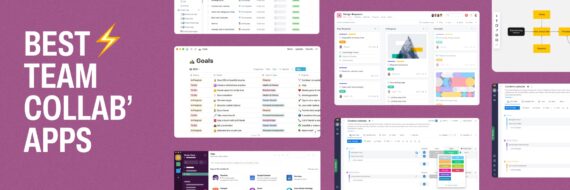Still starting your content strategy with a blank doc? Still finishing it in a panic?
In 2026, top marketing teams aren’t guessing anymore. They’re using AI to plan smarter, write faster, and publish more consistently.
From SEO insights to visual content and automated distribution, AI tools are helping marketers skip the grind and stay ahead.
This guide covers five trends — and the tools you need to make them work..
What are AI tools for content creation?
AI tools for content creation use machine learning to assist with generating, optimizing, or organizing content. They analyze patterns, understand prompts, and help marketers produce assets faster — whether that’s text, visuals, or structure.
These tools don’t replace creative strategy. But when used intentionally, they can reduce the manual load and make your content process more focused, flexible, and scalable.
Key takeaways
- AI helps marketers plan, create, and scale content with less guesswork
- Tools like Jasper, Surfer, Canva, and others streamline work across channels
- Combining AI with smart strategy leads to faster output and better results in 2025
🎬 Learn what Slickplan can do!
We filmed a short video to show you exactly how to use Slickplan
How AI tools are reshaping content creation in 2026
AI has shifted from an emerging tech to a core part of most content workflows. From ideation and writing to SEO and distribution, AI tools are helping teams make faster, more strategic decisions.
According to SEO.com:
93% of brands now use AI to generate content faster
90% use it to make content planning decisions
81% rely on it to extract insights
More than two-thirds say it frees them to focus on creative work
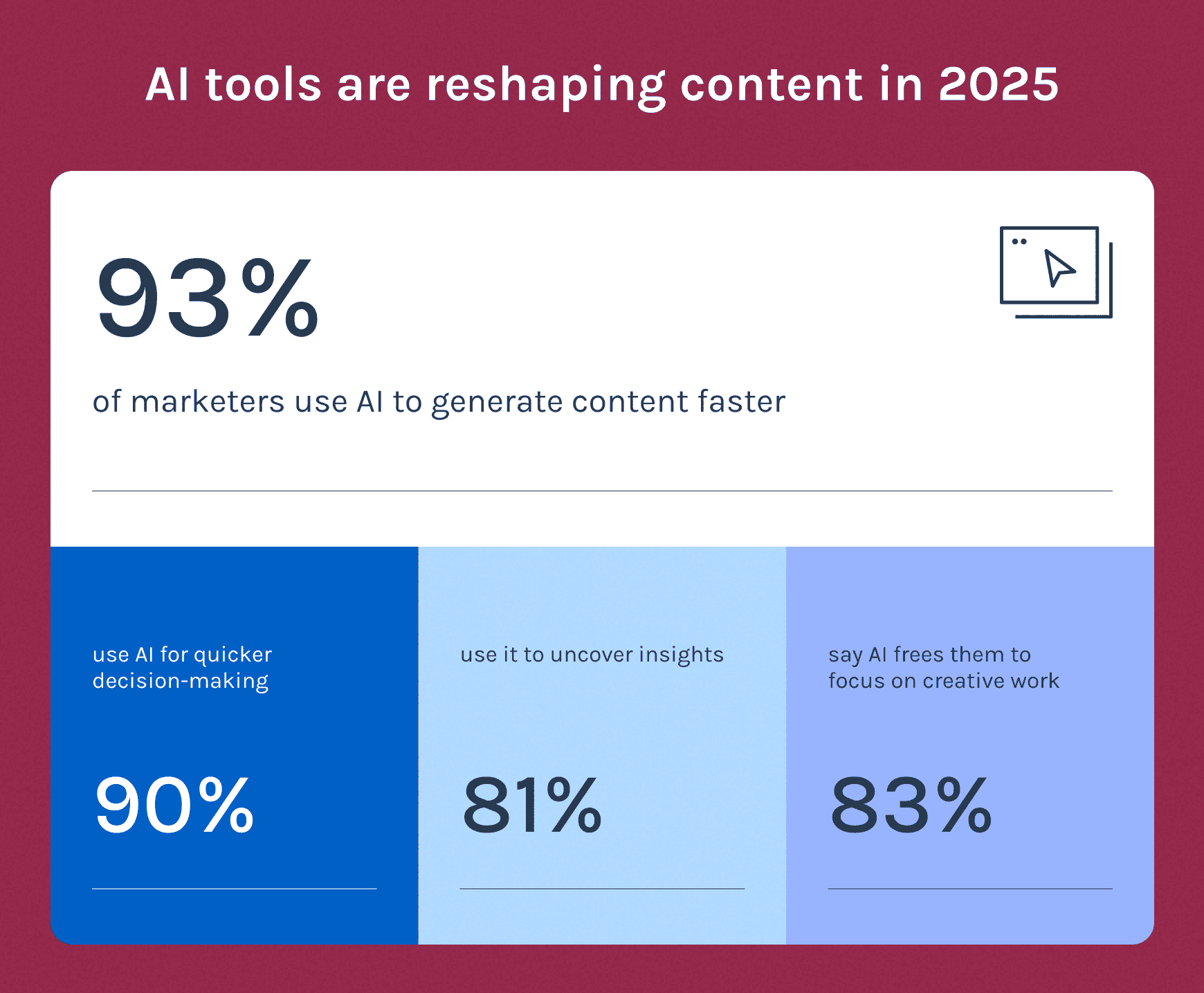
Using generative AI tools for content creation
Generative AI tools like ChatGPT, Jasper, and Canva are transforming content ideation. They help teams scale content creation without starting from scratch. See how developers are bringing ChatGPT into their products.
For example: A strategist launches a campaign. Jasper generates a blog draft, and Canva Magic Studio creates branded social graphics using the same theme.
According to SurveyMonkey:
51% of digital marketers now use generative AI regularly to optimize content across web and social channels.
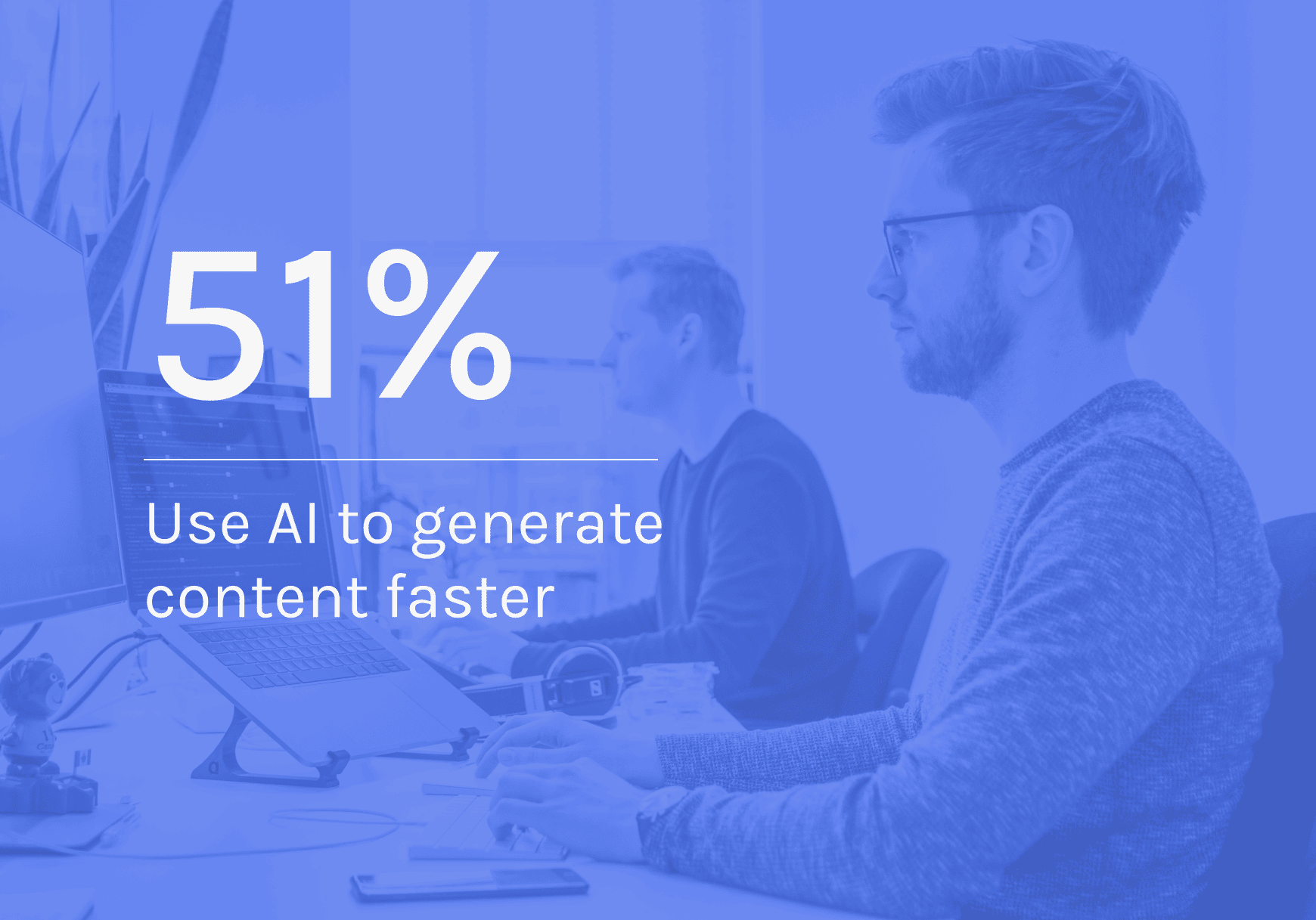
From Harvard’s blog:
“AI is changing the way companies create blog posts, social media messaging, and ad campaigns. Marketers can input specific instructions and generate content tailored to brand voice and audience needs.”
Generative AI is also impacting web app development, allowing non-coders to build prototypes using prompt-driven interfaces.
These tools increase output speed, but strategy, editing, and brand alignment still depend on human oversight.
AI tools for content performance and analytics
AI can process vast amounts of audience and performance data in seconds. During content creation, this supports:
- Identifying top-performing formats and topics
- Uncovering emerging trends in real time
- Personalizing messaging across segments
Instead of guessing, marketers can make decisions based on insight and iterate quickly when performance shifts.
AI tools for SEO and content optimization
AI is also reshaping search optimization. It can support:
- Keyword discovery based on user intent
- Competitive SERP analysis
- On-page SEO audits with content gap insights
According to SeoProfy:
65% of businesses report improved SEO performance with AI
52% of SEO professionals saw better results in on-page optimization
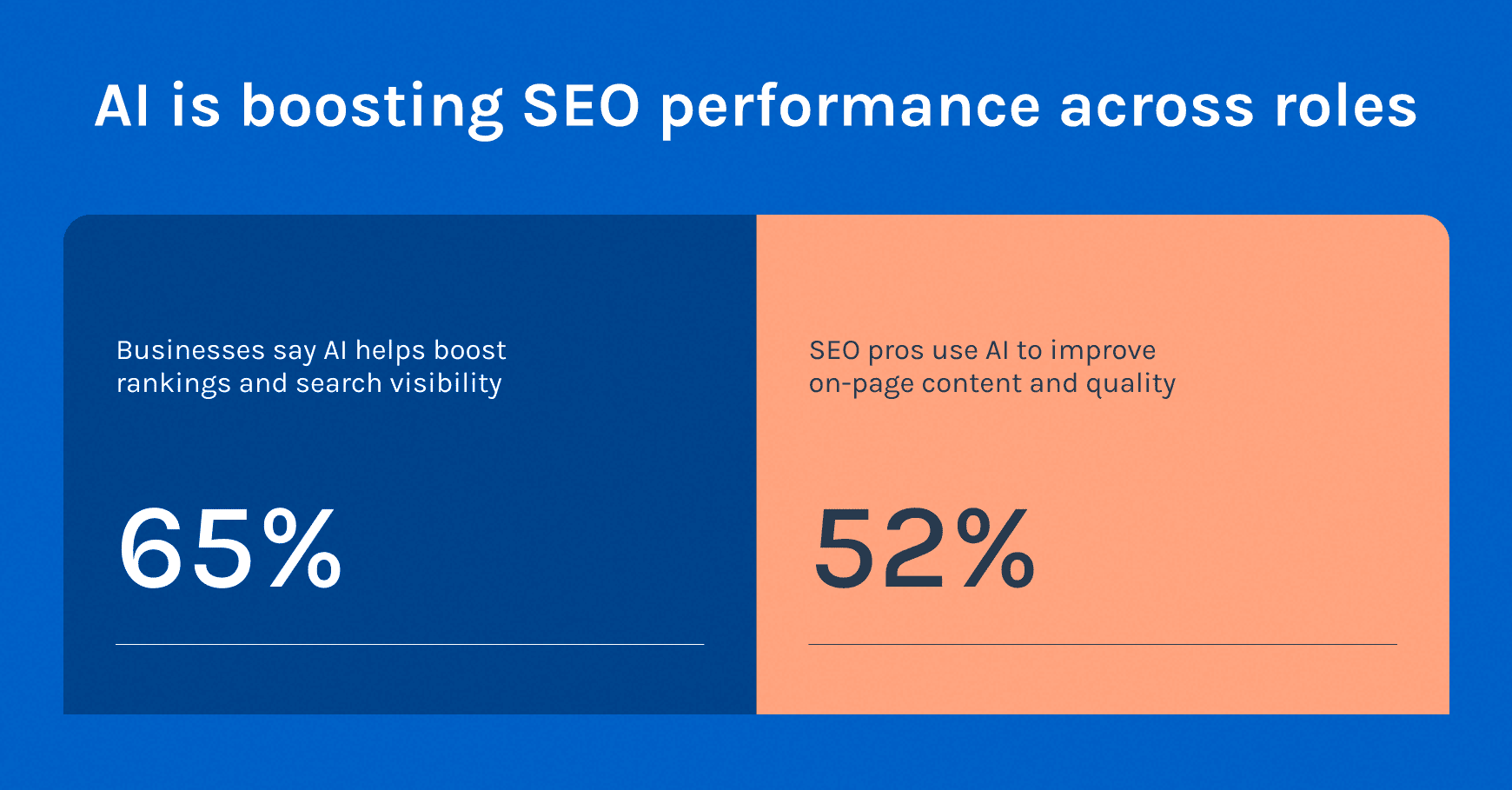
AI tools for content distribution and delivery
Tools like Buffer and Mention use AI to fine-tune distribution. They help:
- Choose the best time to post based on behavior patterns
- Adjust format per platform
- Personalize subject lines and previews in email campaigns
Small adjustments driven by AI lead to stronger engagement, better delivery, and less manual overhead.
Upgrade your 2026 content strategy with these AI-tools
Now that we’ve learnt more about how AI is reshaping the content marketing landscape, let’s take a closer look at how you can use it in your strategy.
From AI-driven content planning to SEO optimization, here are some of the hottest tools to bring on board in 2026.
Jasper: Scalable content writing with brand consistency
Starting from a blank page can slow down even the most experienced marketers. Jasper helps teams overcome that hurdle by generating long-form content, blog drafts, and product copy — all aligned to your brand voice.
Example:
A content manager is launching a campaign targeting B2B SaaS customers. Using Jasper’s Brand Voice feature, they upload past blog posts and tone guides. With that context, Jasper generates a LinkedIn post, email draft, and blog intro tailored to the campaign’s audience and platform.
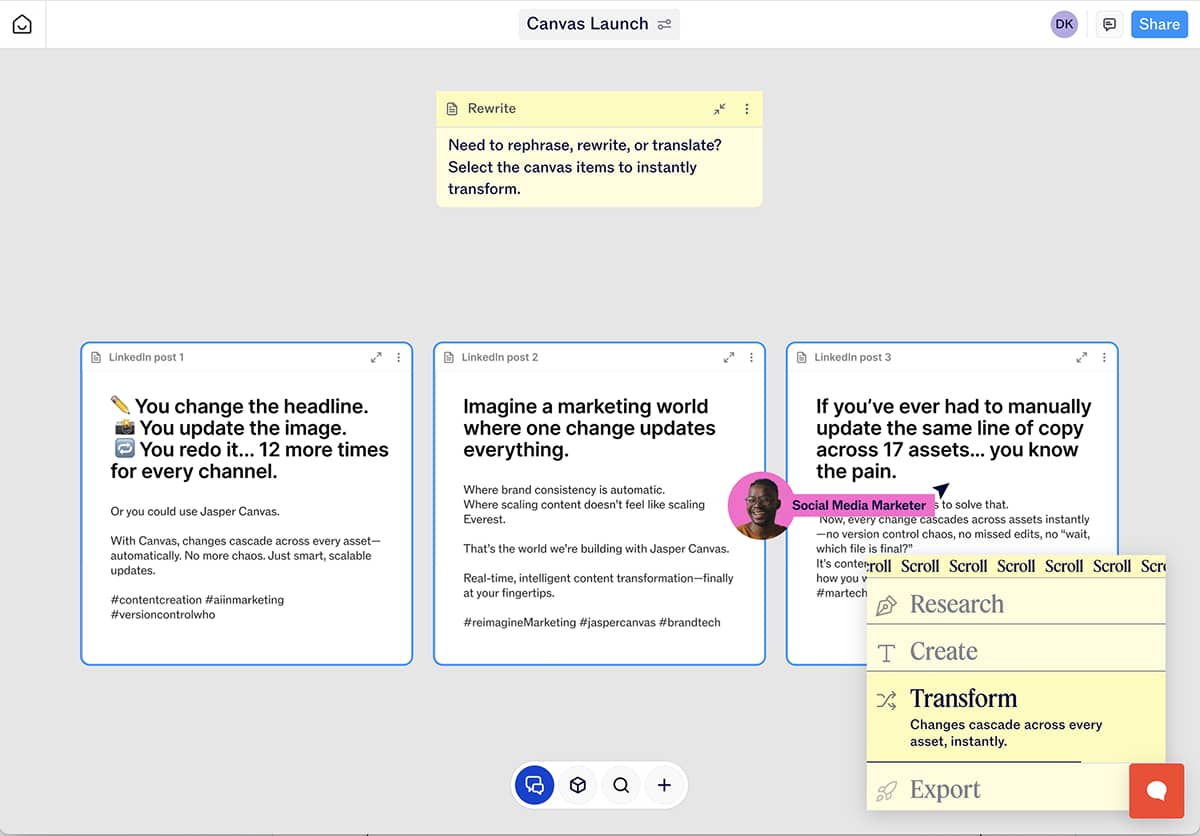
Why Jasper works for content teams:
- Produces SEO-optimized blog posts, landing pages, and product descriptions
- Uses GPT-based AI to align with brand voice and audience intent
- Supports bulk content production without sacrificing quality
- Brand Voice feature adapts writing based on uploaded samples or URLs
- Great for scaling content across multiple formats and channels
For marketers who need consistent output at speed, Jasper removes the friction of traditional content calendars and gives teams a creative starting point that’s already on-brand.
Flick: Smarter social planning with AI
Planning social media content takes more than creativity. Consistency, timing, and platform optimization are what make posts perform. Flick uses AI to streamline that process.
Example:
A digital marketer is planning a product launch campaign across Instagram and LinkedIn. Using Flick’s hashtag suggestion tool, they identify niche hashtags that balance volume and competitiveness. They then schedule variations of each post with optimized captions using the built-in content calendar — ensuring consistent reach without overposting.
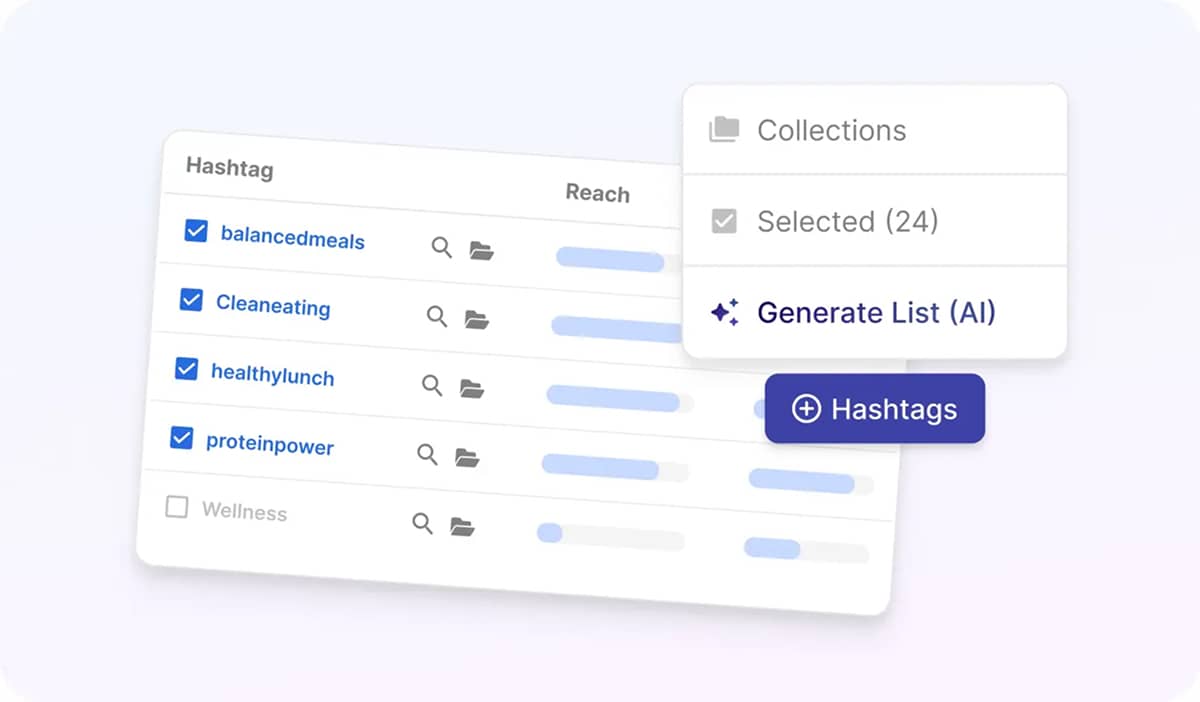
What Flick brings to the table:
- AI-powered caption writing tuned to audience voice and tone
- Intelligent hashtag recommendations based on live platform data
- Content calendar with insights on best posting times
- Campaign folders for organizing captions, hashtags, and post templates
- Performance tracking to monitor results and refine future campaigns
Flick doesn’t just automate posts — it helps marketers make smarter publishing decisions that improve visibility and engagement across channels.
Surfer SEO: Turning content into search performance
High-quality content doesn’t always rank. Surfer SEO helps bridge that gap by showing exactly what your content is missing.
Example:
After publishing a new landing page, a marketing team notices it’s stuck on page two of search results. They run the URL through Surfer’s content audit, which flags missing terms, low semantic density, and weak header structure. Using Surfer’s content editor inside Google Docs, they revise the copy with real-time optimization guidance.Within a week, the page climbs several positions — no extra backlinks required.
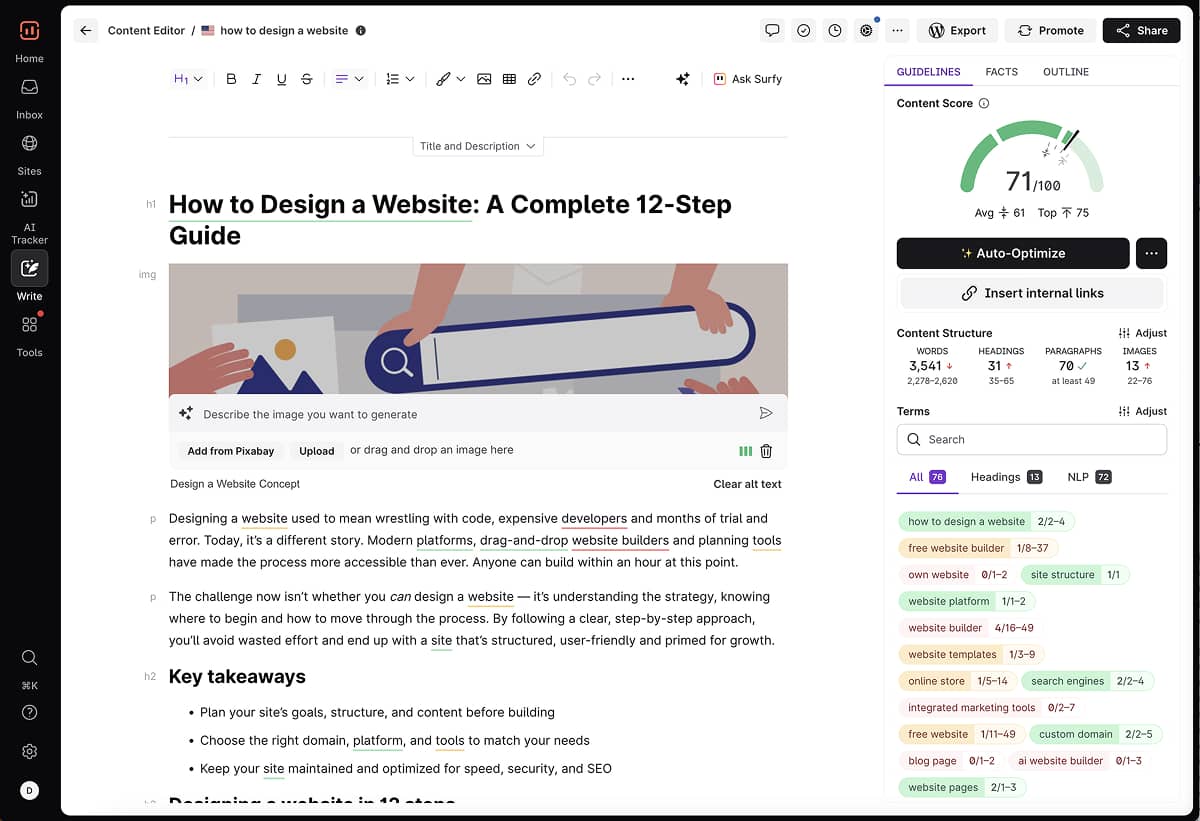
Why Surfer stands out for search optimization:
- Uses natural language processing to score and benchmark content against competitors
- Helps identify missing keywords, weak spots, and structure issues
- Audits underperforming pages and guides updates using SERP analysis
- Integrates directly with Google Docs and WordPress to fit within your existing workflow
Surfer is especially useful when planning SEO-aligned content strategies that rely on topic clusters or pillar pages. It brings clarity and direction to the writing process by translating ranking signals into actionable guidance.
Slickplan: Structuring content before you write
A successful content strategy starts with a solid information architecture. Slickplan makes that process visual and collaborative, helping teams align before any content is written.
Example:
A content strategist and UX designer are preparing a new onboarding flow. Before drafting copy, they use Slickplan’s Visual Sitemap Generator to outline the page hierarchy and define navigational paths. This becomes the foundation for designers, developers, and writers to build on together.
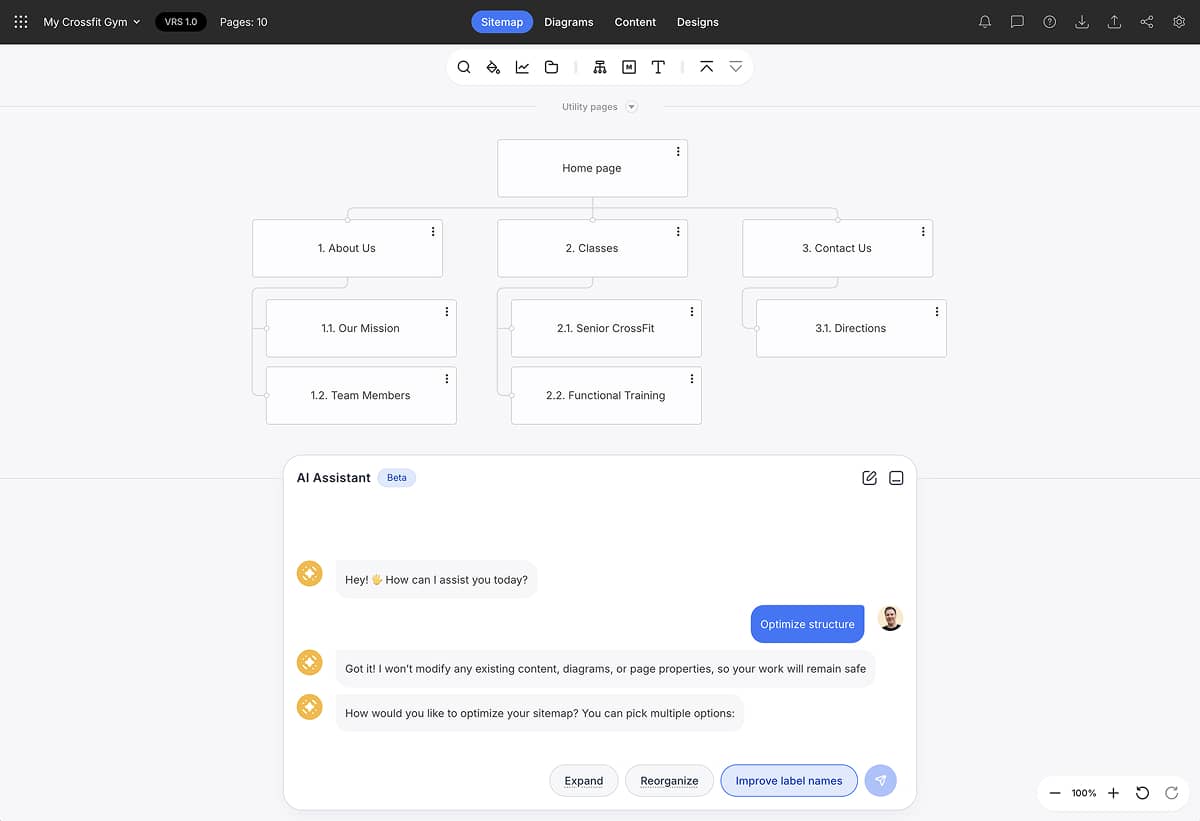
What makes Slickplan essential for planning:
- Design mockup integration allows a seamless transition from structure to visuals
- Page templates and flowcharts simplify IA planning and stakeholder collaboration
- WordPress and Basecamp integrations support content alignment across platforms
- A no-code drag-and-drop interface makes it easy for marketers and strategists to use without technical expertise
Slickplan isn’t powered by AI, but it complements AI tools by providing the structural clarity needed for high-performing content. When the foundation is solid, everything that follows is more effective.
Canva Magic Studio: Visual content made effortless
AI tools have transformed how marketers write — but visuals are just as important. Canva Magic Studio brings generative AI into the design process to help marketers go from idea to creative asset, fast.
Example:
A skincare brand is launching a new eco-friendly product line. The team opens Magic Studio and enters a theme: “clean, modern, minimalist, botanical.” In seconds, the tool generates layout options for Instagram carousels, email banners, and product cards. From there, they adjust colors and text to match the brand — without needing a designer.
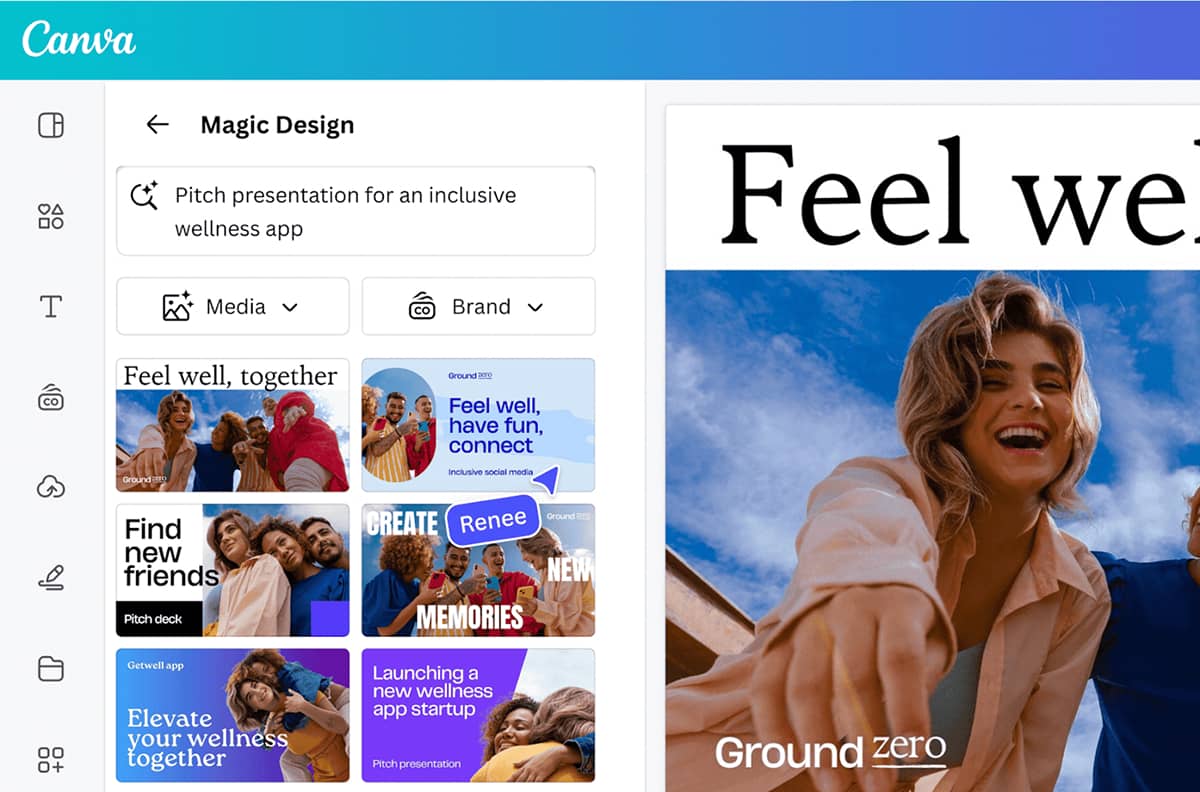
Why Canva Magic Studio works for marketing teams:
- Turns keywords and themes into polished design mockups
- Helps generate assets for presentations, social, email, and more
- Offers branded style suggestions based on your input
- Speeds up early-stage visual ideation and concepting
- Accessible for non-designers — no layout skills required
As content formats evolve, Canva’s AI-powered design suite helps marketers keep pace by reducing creative friction and making it easier to experiment with new formats.
Bulkly: Automating social distribution with AI
Creating great content is only half the job. Getting it in front of the right audience, at the right time, is what drives results. Bulkly helps marketing teams automate the repetitive side of social sharing so campaigns stay active long after they’re published.
Example:
A content manager wants to keep evergreen posts circulating across LinkedIn, X, and Facebook. Using Bulkly’s AI-driven scheduler, they set recurring posts, upload content in bulk via CSV, and let the platform automatically repurpose updates pulled from their RSS feeds.
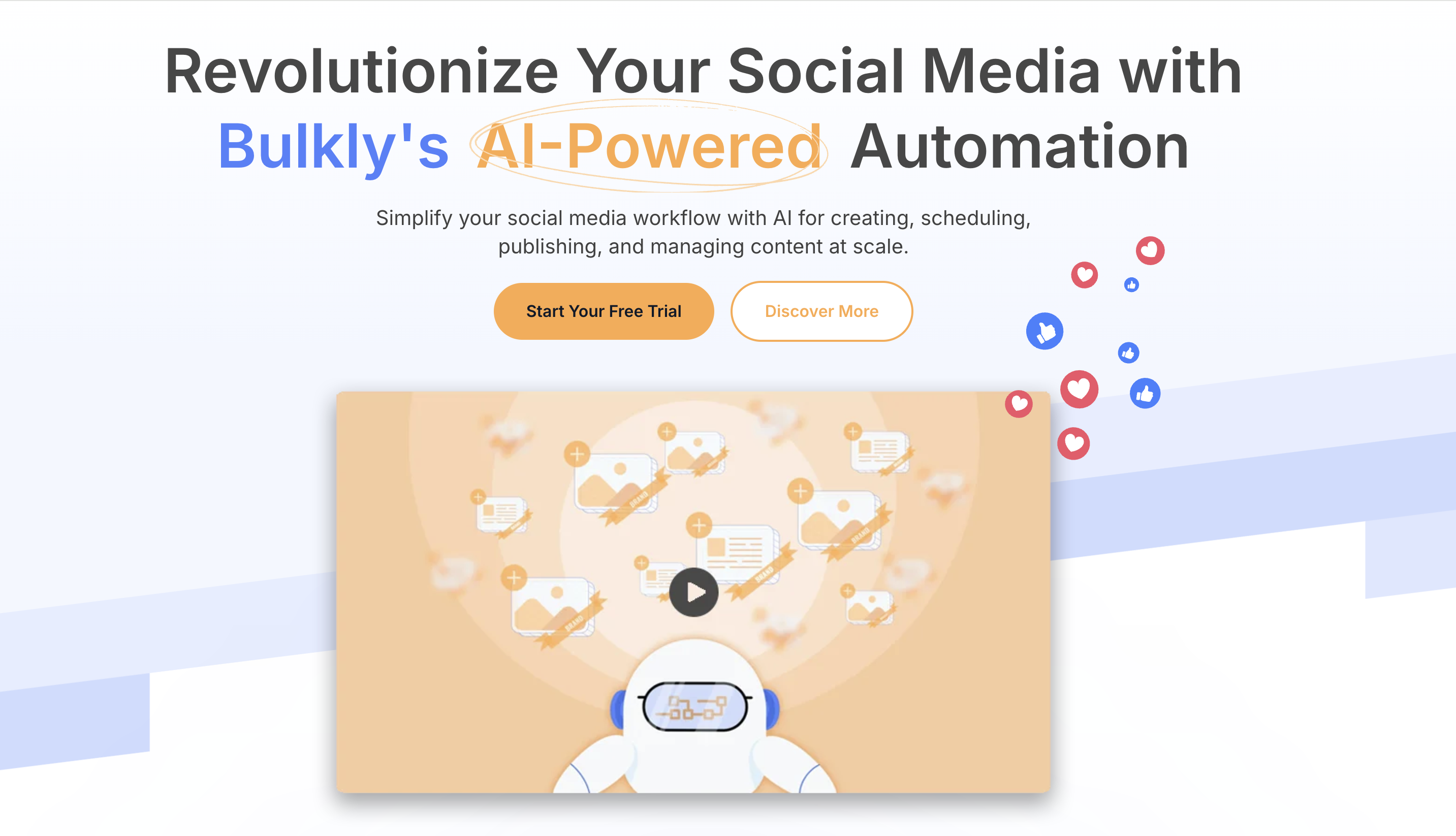
Why Bulkly matters for content teams:
- AI-powered scheduling and automation for major social platforms
- Built-in content recycling keeps feeds fresh without extra effort
- Hashtag and timing recommendations to improve reach
- Workspace system ideal for agencies or multi-brand teams
Bulkly’s automation takes the grind out of social media distribution, giving marketers more time to focus on strategy and creative output.
Where AI tools fit in your content creation strategy
The smartest marketers in 2026 aren’t just creating more content — they’re creating better content, faster.
From long-form blog posts and branded visuals to landing pages and product interfaces, generative tools are reshaping how teams work. This shift isn’t coming — it’s already here.
The future of content creation is personal, data-driven, and powered by the right balance of human insight and automation.
AI won’t replace your voice. But it can help you scale it, sharpen it, and stay ahead without burning out.
When used strategically, these tools become a natural extension of your workflow — especially when paired with a strong SEO content strategy.
And as your content becomes more dynamic and distributed, having a thoughtful website design foundation ensures that what you create is supported by structure, usability, and visual clarity.
The teams that win in this new era won’t just adopt tools. They’ll know when to automate, when to collaborate, and when to take the creative lead.
Plan smarter content with Slickplan
A collaborative workspace to handle all your content needs. Plan, gather and create together.
AI content tools FAQs
Can AI do content creation?
Yes — generative AI tools like Jasper, ChatGPT, and Canva can create content including blog posts, product descriptions, visuals, and social captions. These tools use prompts and existing content to generate results quickly, often with surprisingly strong first drafts.
Which AI tool is best for social media content?
Tools like Flick are designed specifically for social content. They help optimize captions, suggest hashtags, and schedule posts based on engagement trends. Canva is also a strong choice for social visuals.
Is there a free AI tool to generate content?
Yes. Several AI tools offer free plans or trials, including Canva, Copy.ai, and Rytr. These are good for testing basic capabilities before committing to a paid subscription.
Can AI tools help improve SEO rankings?
Definitely. AI tools like Surfer SEO analyze high-ranking content, recommend keyword usage, and help you fill content gaps. You can pair those insights with a tool like the Slickplan Content Planner to structure and publish your content more strategically.
Can generative AI match a brand's tone of voice?
With the right input, yes. Many AI tools let you upload writing samples or brand guidelines, which they use to mimic your voice. You'll still want to review the output — but it's a major time saver and consistency booster.
Are AI content tools expensive?
Some are — but many offer budget-friendly entry plans. Tools like Jasper and Canva have scalable pricing, so smaller teams can start affordably and upgrade as needed.
What is the best AI tool for marketers in 2025?
It depends on your needs. Jasper is strong for written content, Canva for visuals, Flick for social media, and Surfer SEO for optimization. Many teams use a combination to support the full content lifecycle.
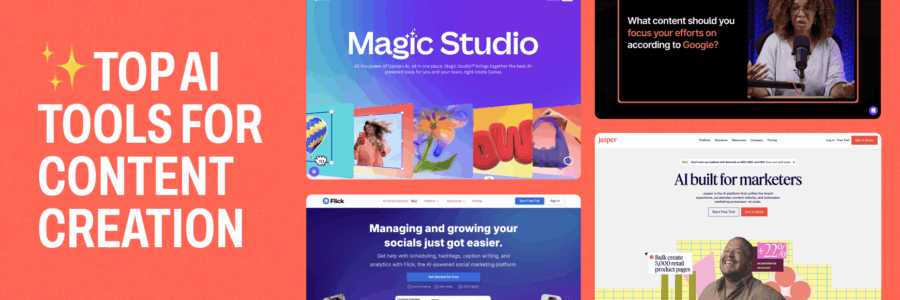




 X
X
